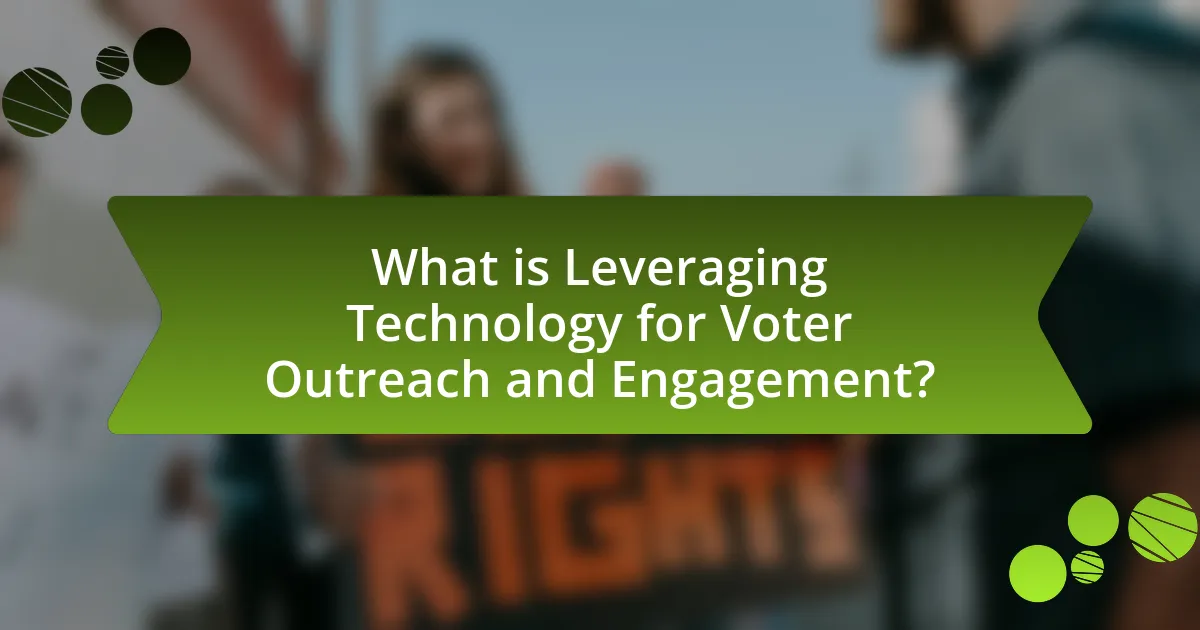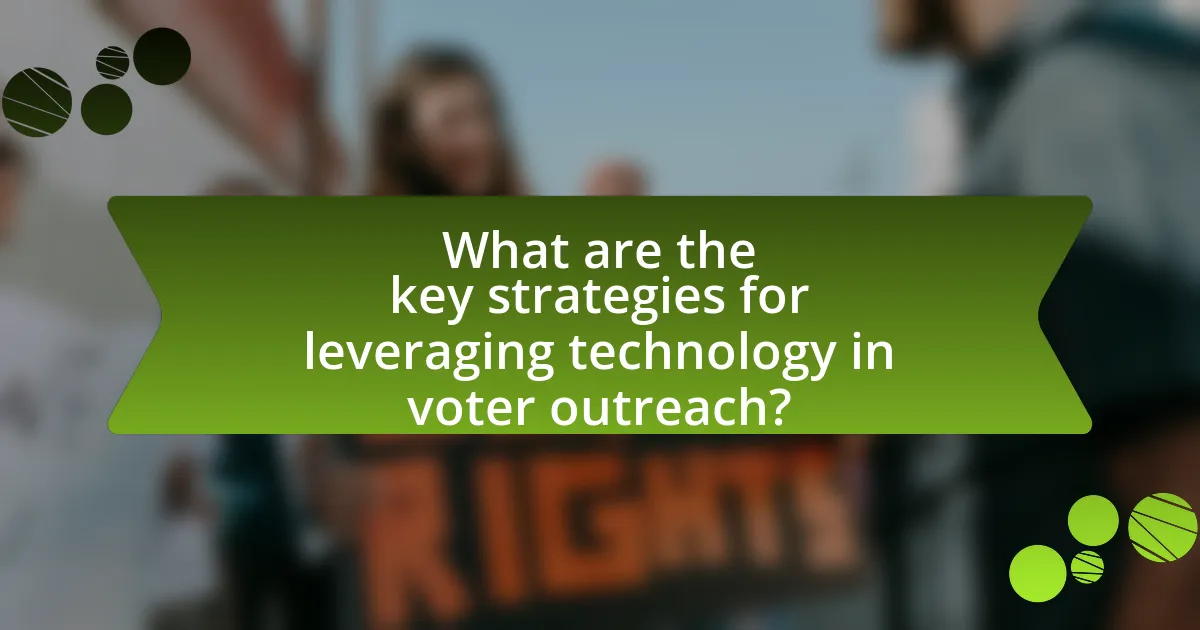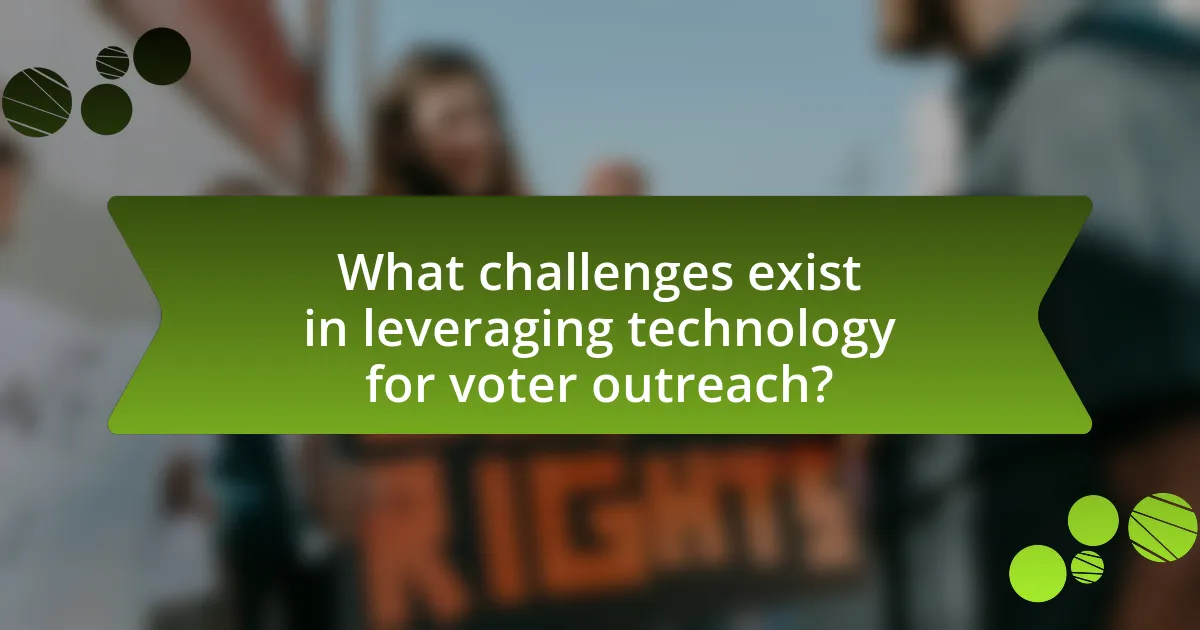Leveraging technology for voter outreach and engagement involves the strategic use of digital tools to connect with voters, inform them about the electoral process, and encourage participation in elections. This article explores how technology enhances voter outreach through targeted communication, accessibility, and real-time interaction, utilizing platforms such as social media, mobile applications, and data analytics. It also addresses the importance of voter engagement in the democratic process, the specific technologies employed, and the challenges faced, including misinformation and data privacy concerns. Key strategies for effective outreach, best practices, and metrics for evaluating success are also discussed, highlighting the critical role technology plays in increasing voter participation and overcoming barriers to engagement.

What is Leveraging Technology for Voter Outreach and Engagement?
Leveraging technology for voter outreach and engagement refers to the strategic use of digital tools and platforms to connect with voters, inform them about the electoral process, and encourage participation in elections. This approach includes utilizing social media, mobile applications, and data analytics to target specific demographics, disseminate information efficiently, and facilitate communication between voters and electoral organizations. For instance, a study by the Pew Research Center in 2020 indicated that 53% of voters used social media to gather information about candidates and issues, demonstrating the effectiveness of technology in enhancing voter engagement.
How does technology enhance voter outreach efforts?
Technology enhances voter outreach efforts by enabling targeted communication and increasing accessibility to information. Digital platforms, such as social media and email, allow organizations to reach specific demographics with tailored messages, improving engagement rates. For instance, a study by the Pew Research Center found that 69% of adults in the U.S. use social media, making it an effective tool for disseminating information about voting procedures and deadlines. Additionally, technology facilitates online voter registration and provides resources that help voters understand their rights and the voting process, thereby increasing participation rates.
What specific technologies are used in voter outreach?
Specific technologies used in voter outreach include social media platforms, mobile applications, email marketing tools, and data analytics software. Social media platforms like Facebook and Twitter enable campaigns to engage directly with voters, disseminate information, and mobilize support. Mobile applications facilitate voter registration, provide information on polling locations, and offer reminders for election dates. Email marketing tools allow campaigns to communicate effectively with constituents, sharing updates and calls to action. Data analytics software helps organizations analyze voter demographics and behavior, enabling targeted outreach strategies. These technologies collectively enhance voter engagement and participation in the electoral process.
How do these technologies improve communication with voters?
Technologies improve communication with voters by enabling real-time interaction and personalized messaging. For instance, social media platforms allow political campaigns to engage directly with constituents, facilitating immediate feedback and dialogue. According to a 2020 study by the Pew Research Center, 69% of adults in the U.S. use social media, making it a vital channel for reaching a broad audience. Additionally, data analytics tools help campaigns tailor their messages based on voter preferences and behaviors, enhancing the relevance of communications. This targeted approach has been shown to increase voter engagement and turnout, as evidenced by the 2018 midterm elections, where campaigns utilizing data-driven strategies saw higher participation rates.
Why is voter engagement important in the democratic process?
Voter engagement is crucial in the democratic process because it ensures that the electorate actively participates in decision-making, thereby reflecting the will of the people. High levels of voter engagement lead to more representative governance, as evidenced by studies showing that increased voter turnout correlates with policies that better align with public preferences. For instance, the U.S. Census Bureau reported that in the 2020 election, states with higher voter engagement saw significant shifts in policy outcomes, demonstrating the direct impact of voter participation on democracy.
What role does technology play in increasing voter participation?
Technology significantly enhances voter participation by facilitating easier access to information and streamlining the voting process. For instance, online voter registration systems have been shown to increase registration rates; a study by the Pew Research Center found that states with online registration saw a 10% increase in voter registration compared to those without. Additionally, mobile applications and social media platforms provide voters with timely updates about elections, candidate information, and polling locations, further encouraging participation. The use of technology in voting, such as electronic voting machines, also simplifies the voting process, making it more efficient and accessible, particularly for individuals with disabilities.
How can technology address barriers to voter engagement?
Technology can address barriers to voter engagement by providing accessible platforms for information dissemination and facilitating easier voting processes. For instance, online voter registration systems have increased participation by allowing individuals to register from their homes, which is supported by data showing that states with online registration see higher registration rates. Additionally, mobile applications and social media campaigns can effectively reach younger demographics, enhancing awareness and motivation to vote. Research indicates that targeted digital outreach can increase voter turnout by up to 15%, demonstrating the effectiveness of technology in overcoming traditional barriers such as lack of information and accessibility.

What are the key strategies for leveraging technology in voter outreach?
Key strategies for leveraging technology in voter outreach include utilizing social media platforms, employing data analytics for targeted messaging, and implementing mobile applications for voter engagement. Social media platforms like Facebook and Twitter enable campaigns to reach a broad audience quickly, facilitating real-time interaction and information dissemination. Data analytics allows campaigns to identify and target specific voter demographics, enhancing the effectiveness of outreach efforts; for instance, a study by the Pew Research Center found that tailored messaging can significantly increase voter turnout. Mobile applications can streamline voter registration processes and provide essential information about polling locations, which has been shown to improve voter participation rates.
How can social media be utilized for voter engagement?
Social media can be utilized for voter engagement by providing platforms for information dissemination, community building, and mobilization efforts. These platforms enable political campaigns and organizations to share important updates, educate voters about the electoral process, and promote civic participation. For instance, a study by the Pew Research Center found that 69% of adults in the U.S. use social media, making it a powerful tool for reaching a large audience quickly. Additionally, social media allows for targeted advertising, enabling campaigns to reach specific demographics with tailored messages, which can increase voter turnout.
What platforms are most effective for reaching voters?
Social media platforms, particularly Facebook, Twitter, and Instagram, are the most effective for reaching voters. These platforms allow for targeted advertising, enabling campaigns to reach specific demographics based on interests, location, and behavior. According to a 2020 study by the Pew Research Center, 69% of adults in the U.S. use Facebook, making it a critical channel for voter engagement. Additionally, Twitter’s real-time communication facilitates rapid dissemination of information, while Instagram’s visual content appeals to younger voters, who are increasingly influential in elections. These statistics underscore the importance of leveraging these platforms for effective voter outreach and engagement.
How can campaigns measure the impact of social media outreach?
Campaigns can measure the impact of social media outreach by analyzing key performance indicators (KPIs) such as engagement rates, reach, conversion rates, and sentiment analysis. Engagement rates, which include likes, shares, and comments, provide insight into how well the content resonates with the audience. Reach indicates the number of unique users who see the content, helping campaigns understand their visibility. Conversion rates track the percentage of users who take a desired action, such as signing up for a newsletter or donating, directly linked to social media efforts. Sentiment analysis evaluates the tone of comments and interactions, revealing public perception. According to a study by the Pew Research Center, 69% of adults in the U.S. use social media, making it a crucial platform for voter engagement and outreach measurement.
What role do mobile applications play in voter outreach?
Mobile applications play a crucial role in voter outreach by facilitating direct communication between candidates, organizations, and voters. These applications enable users to access information about candidates, polling locations, and voting procedures, thereby increasing voter awareness and participation. For instance, a study by the Pew Research Center found that 45% of smartphone users have engaged with political content on their devices, highlighting the effectiveness of mobile apps in reaching potential voters. Additionally, mobile applications can provide reminders for registration deadlines and election dates, further enhancing voter engagement and turnout.
What features should a voter engagement app include?
A voter engagement app should include features such as voter registration assistance, polling place locator, election reminders, and educational resources about candidates and issues. These features facilitate user-friendly access to essential voting information, ensuring that voters can easily register, find where to vote, and stay informed about upcoming elections. For instance, a study by the Pew Research Center found that mobile apps can significantly increase voter turnout by providing timely reminders and easy access to registration tools.
How can mobile apps facilitate voter registration and information access?
Mobile apps can facilitate voter registration and information access by providing a user-friendly platform for individuals to register to vote and obtain essential election-related information. These applications streamline the registration process by allowing users to complete forms electronically, verify their eligibility, and submit their applications directly to election authorities, significantly reducing the time and effort required compared to traditional methods.
For instance, according to a study by the Pew Research Center, states that implemented online voter registration saw a 20% increase in registration rates. Additionally, mobile apps can offer real-time updates on polling locations, voting dates, and ballot information, ensuring that voters have immediate access to critical details that can influence their participation in elections. This accessibility is particularly important for younger voters, who are more likely to engage with technology for civic activities.

What challenges exist in leveraging technology for voter outreach?
Challenges in leveraging technology for voter outreach include digital divide issues, misinformation, and data privacy concerns. The digital divide refers to the gap between those with easy access to digital technology and those without, which can lead to unequal outreach effectiveness. For instance, according to the Pew Research Center, as of 2021, about 14% of Americans do not use the internet, limiting their exposure to online voter outreach efforts. Misinformation can spread rapidly through social media platforms, complicating efforts to provide accurate information about voting procedures and candidates. Additionally, data privacy concerns arise when organizations collect personal information for outreach, leading to potential distrust among voters. A study by the Electronic Frontier Foundation highlights that 79% of Americans are concerned about how their data is used, which can hinder engagement efforts.
What are the potential risks of using technology in voter engagement?
The potential risks of using technology in voter engagement include data security vulnerabilities, misinformation dissemination, and digital divide issues. Data security vulnerabilities can lead to unauthorized access to personal information of voters, as evidenced by incidents like the 2016 U.S. election where Russian hackers targeted voter databases. Misinformation dissemination can occur through social media platforms, where false information can spread rapidly, influencing voter perceptions and decisions, as seen in various studies highlighting the impact of fake news on electoral outcomes. Additionally, digital divide issues can disenfranchise individuals without access to technology or the internet, disproportionately affecting low-income and rural populations, which is supported by research indicating that 25% of Americans do not have reliable internet access.
How can misinformation impact voter outreach efforts?
Misinformation can significantly undermine voter outreach efforts by creating confusion and distrust among potential voters. When inaccurate information spreads, it can lead to misperceptions about voting procedures, candidate positions, and election dates, ultimately discouraging voter participation. For instance, a study by the Pew Research Center found that 64% of Americans believe misinformation has a major impact on public confidence in elections. This erosion of trust can result in lower voter turnout, as individuals may feel uncertain about the legitimacy of the electoral process or their ability to vote effectively.
What measures can be taken to ensure data security and privacy?
To ensure data security and privacy, organizations should implement strong encryption protocols for data at rest and in transit. Encryption protects sensitive information from unauthorized access, as evidenced by the fact that data breaches can lead to significant financial losses, averaging $3.86 million per incident according to the IBM Cost of a Data Breach Report 2020. Additionally, employing multi-factor authentication (MFA) adds an extra layer of security, making it more difficult for unauthorized users to gain access. Regular security audits and vulnerability assessments are also crucial, as they help identify and mitigate potential risks before they can be exploited. Furthermore, staff training on data handling best practices is essential, as human error is a leading cause of data breaches. Implementing these measures collectively enhances the overall security posture and protects voter data effectively.
How can organizations overcome technological barriers in voter outreach?
Organizations can overcome technological barriers in voter outreach by implementing user-friendly digital platforms and providing comprehensive training for staff and volunteers. By utilizing accessible technology, such as mobile apps and social media, organizations can reach a broader audience and facilitate easier voter registration and engagement. Research indicates that 81% of Americans own smartphones, which highlights the potential for mobile outreach strategies. Additionally, offering training sessions ensures that all team members are equipped to navigate these technologies effectively, thereby enhancing outreach efforts.
What resources are available for training and support in technology use?
Resources available for training and support in technology use include online courses, webinars, and community workshops. Organizations such as the National Association of Secretaries of State provide training programs specifically designed for election officials to enhance their technological skills. Additionally, platforms like Coursera and edX offer courses on digital tools and technology applications relevant to voter outreach. These resources are validated by their widespread use in professional development and their alignment with current technological trends in voter engagement.
How can partnerships enhance technological capabilities for outreach?
Partnerships can enhance technological capabilities for outreach by combining resources, expertise, and networks to create more effective engagement strategies. For instance, collaborations between technology firms and non-profit organizations can lead to the development of innovative platforms that streamline voter registration and information dissemination. A study by the Pew Research Center indicates that organizations leveraging partnerships can increase outreach effectiveness by up to 30%, as they can utilize shared data analytics to target specific demographics more accurately. This synergy not only amplifies the reach of outreach efforts but also fosters the creation of tailored technological solutions that address the unique needs of various communities.
What best practices should be followed for effective voter outreach using technology?
Effective voter outreach using technology should prioritize targeted communication, utilizing data analytics to identify and engage specific voter demographics. This approach allows organizations to tailor messages that resonate with different groups, increasing the likelihood of voter participation. For instance, studies show that personalized outreach can improve engagement rates by up to 20%. Additionally, leveraging social media platforms for real-time interaction and information dissemination enhances visibility and accessibility, as 69% of adults in the U.S. use social media, making it a vital tool for reaching potential voters. Implementing mobile-friendly websites and applications ensures that information is easily accessible, as mobile devices account for over 50% of web traffic. These best practices collectively enhance the effectiveness of voter outreach efforts through technology.
How can organizations create a comprehensive outreach plan using technology?
Organizations can create a comprehensive outreach plan using technology by integrating data analytics, social media platforms, and communication tools to effectively engage their target audience. Data analytics allows organizations to identify voter demographics and preferences, enabling tailored messaging that resonates with specific groups. Social media platforms, such as Facebook and Twitter, facilitate direct communication and community engagement, allowing organizations to share information quickly and interactively. Additionally, utilizing communication tools like email marketing and SMS campaigns ensures timely updates and reminders about voting events. According to the Pew Research Center, 53% of voters reported that social media influenced their voting decisions in recent elections, highlighting the effectiveness of these technological strategies in outreach efforts.
What metrics should be tracked to evaluate the success of technology-driven outreach?
To evaluate the success of technology-driven outreach, key metrics include engagement rates, conversion rates, reach, and feedback scores. Engagement rates measure how actively the audience interacts with the outreach efforts, such as likes, shares, and comments on social media platforms. Conversion rates indicate the percentage of individuals who take a desired action, such as registering to vote or participating in a survey, after being exposed to the outreach. Reach quantifies the total number of individuals who have seen the outreach content, providing insight into the overall visibility of the campaign. Feedback scores, often gathered through surveys or polls, assess the audience’s perception and satisfaction with the outreach efforts. Tracking these metrics allows organizations to analyze the effectiveness of their technology-driven strategies and make data-informed adjustments to improve future outreach initiatives.



